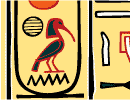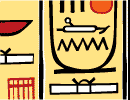The New York Times -- November 14, 1999
Making a God More
Human
By ANNETTE GRANT
 ELL
EL-AMARNA, Egypt -- LOUIS XIV was a mere parvenu in the Sun
King business. The first Sun King was the Egyptian pharaoh Ikhnaton,
who lived some 30 centuries before Louis and built on this spot an
opulent royal city that was the Versailles of its day. He called the
city Ikhtaton, Horizon of the Sun, in honor of the sun god Aton, whose
name was incorporated in his own, meaning Servant of the Sun. From his
new capital on the Nile, roughly midway between Memphis and Thebes,
Ikhnaton and his celebrated wife, Nefertiti, governed Egypt for
12 of the 17 years of his rule, from 1353 to 1336 B.C., and
established a one-god (Aton) religion to supplant the polytheistic
system that had obtained for centuries.
ELL
EL-AMARNA, Egypt -- LOUIS XIV was a mere parvenu in the Sun
King business. The first Sun King was the Egyptian pharaoh Ikhnaton,
who lived some 30 centuries before Louis and built on this spot an
opulent royal city that was the Versailles of its day. He called the
city Ikhtaton, Horizon of the Sun, in honor of the sun god Aton, whose
name was incorporated in his own, meaning Servant of the Sun. From his
new capital on the Nile, roughly midway between Memphis and Thebes,
Ikhnaton and his celebrated wife, Nefertiti, governed Egypt for
12 of the 17 years of his rule, from 1353 to 1336 B.C., and
established a one-god (Aton) religion to supplant the polytheistic
system that had obtained for centuries.
Today, little remains at Ikhtaton, long called Amarna, but the
foundations of mud-brick temples, palaces and houses, and millions of
potsherds. The royal tombs, in the hills east of the 10-mile-long,
4-mile-wide city, were robbed and defaced long ago, leaving only wall
murals incised in plaster that is endangered now not by vandals but by
salt from Egypt's rising water table.
Yet enough first-class material survived (some of it by chance when
subsequent pharaohs co-opted it for their own building projects) here
and at Karnak in Thebes to provide a tantalizing picture of a monarch
who wrought changes in religion and art so heretical that after his
death he was declared a nonperson, his face and name deleted from
monuments and his fabulous city razed.
A glimpse into the mysteries of Ikhnaton's world can be had
starting today through Feb. 6 at the Museum of Fine Arts, Boston,
where more than 250 pieces of sculpture, relief, ceramics, jewelry,
tools and furniture have been collected for an exhibition titled
"Pharaohs of the Sun: Ikhnaton, Nefertiti, Tutankhamen."
(Ancient Egyptian names are transliterated many different ways;
Ikhnaton is often rendered Akhenaten or Akhnaten.) Dr. Rita E. Freed,
the museum's Norma-Jean Calderwood curator of ancient
Egyptian, Nubian and Near Eastern art and the show's organizer,
spent four years negotiating the loans necessary to flesh out the
Amarna period of the New Kingdom dynasties, which are reckoned from
1539 to 1075 B.C.
Dr. Freed pulled off a considerable coup in getting for the show
two colossal heads of Ikhnaton never seen outside Egypt. These
sandstone heads, each weighing more than a ton, were among about 30
statues of the pharaoh found at Karnak by Henri Chevrier in 1925. They
have been in storage at the Egyptian Museum in Cairo, which has lent
28 objects to the exhibition.
The style of these statues marks a startling departure from the
standard depiction of pharaohs. The status symbols -- the uraeus
(cobra) on the crown, the crook and flail crossed on the chest, the
clip-on beard -- are all in place. But the face has taken on a
pronounced V shape, with heavily lidded eyes, a very long nose and
full, pouting lips. Age lines frame the mouth.
Whether Ikhnaton (or Nefertiti) actually looked like their statues
or drawings may never be known, for idealization rather than likeness
was the general rule for royalty, and the queen was often given the
features of the king. Their mummies might provide a clue, but they
have disappeared. Still, Ikhnaton certainly approved the depiction,
for his chief sculptor, Bak, testifies in an inscription that the
pharaoh closely supervised his work.
The stylistic shift seen in these colossuses started before
Ikhnaton was pharaoh -- before he was even Ikhnaton but still
Amenhotep IV. His father, Amenhotep III, was a powerful king who had
made Egypt rich and secure enough to welcome innovation. Though
the Amenhoteps, whose name incorporates the god Amon, built the usual
temples for themselves, the traditional portraits show some
eccentricities. In the Boston exhibition, a life-size torso of the
aging and portly Amenhotep III is a sign of changing times.
Early in his reign, Amenhotep IV underwent a conversion, breaking
completely with his forebears. By Year 5, he had changed his name,
declared Aton, until then a minor deity favored by his father, the one
true god and set out with his family, court, artists and craftsmen to
build his sun city, where he would live as Aton's sole high priest.
The development caused consternation among the long-established
priesthood of Amon, especially when Ikhnaton ordered all mention of
Amon erased and statues of him destroyed throughout the land. In
Ikhnaton's own city, which was rising at a dazzling rate and soon had
a population of 20,000, Aton was rendered not as a man but as a
radiant disk whose beneficent rays, bearing ankhs, the symbol of life,
beamed down on the royal family.
With Amon gone, along with the legions of gods who ritually guided
the dead through eternity, the principal subject left to artists was
royal and daily life. They embraced their task with apparent zeal. One
of the greatest of these artists, Thutmose, ran a studio compound in
the capital city that produced numerous statues, including the famous
unfinished bust of Nefertiti discovered in 1912 by German
archaeologists and given to the Egyptian Museum in Berlin. This
sculpture never travels, but others from Thutmose's workshop are in
Boston and amply illustrate the lifelike candor the master carver
coaxed from stone, clay and plaster.
The new style also evolved in painting and bas-reliefs, though
age-old conventions were still observed. The largest person in a scene
continued to be the most important, the smallest the least. People
strode forward in profile with the shoulders and chest seen frontally,
and the king still usually faced right, the power direction.
But rigidity was giving way to informality in scenes that look more
like real-time snapshots than stage sets. For the first time the royal
couple was shown eating, and the Cairo museum has lent the show a
charming sculptor's model of a princess nibbling on a roasted duck.
Emotions were expressed. The king and queen kissed, played with their
children, wept when one of their six daughters died.
There were portrayals of age, and in place of the wasp waist, a
strange corpulence caused stomachs to sag over low-slung waistbands.
Buttocks and thighs swelled voluptuously under skinny chests while
calves and arms became thin, and hands looked effete and boneless.
Suddenly there were five articulated toes on the outer foot, with
toenails.
And there was a distinct slouch, accentuated by deep carving that
produced a dramatic chiaroscuro in open-to-the-sun temples. If bodies
looked elongated, even deformed, they were. The strict proportion of
the canonical figure was based on 18 units the size of its fist; at
Amarna the number increases to 20, the extra two added above the knee.
Many scholars think the deliberate distortion in Amarnan art
indicates that the king suffered from some physical affliction; others
suggest it was the declaration of a cultural revolution: a new god
served by new rituals demanded new art.
From the evidence of some of that art, Ikhnaton didn't wage
extensive wars (which is historically true) and didn't care for
hunting, the usual sport of kings. Yet he enjoyed ceremonies like
riding along the Royal Road in his chariot plated in electrum (a
gold-silver alloy) to his midtown palace, where from the Window of
Appearance he and Nefertiti distributed rewards, often necklaces and
rings, to favored courtiers.
Nefertiti wielded more power in the empire than most previous
queens, which might qualify Ikhnaton as the first feminist. At Amarna,
Nefertiti is often shown the same size as the king, and she also
stands with him as an equal at political events and in tributes to
Aton. She even drives her own chariot. In Boston, one unusual fragment
shows Nefertiti in what is called a "smiting" position, a traditional
saber-rattling pose in which the king threatens an enemy, whom he
holds by the hair. She was the first queen to be represented in this
attitude.
Some experts think Nefertiti took over as pharaoh when Ikhnaton
died, but the evidence is mixed on that point. What certainly did
happen under the next major ruler, the boy-king Tutankhamen, is that
Ikhnaton's world and philosophy came tumbling down. It is worth noting
that Tutankhamen was born Tutankhaton and married one of Ikhnaton's
daughters, who may have been his half or even full sister. Probably
under pressure from advisers, he moved the capital back to traditional
centers, changed his name and restored the old priesthood of Amon.
As the citizens left the capital, so did the artists. Some headed
south to Thebes, where their work is visible at Karnak and in the
Valley of the Kings in Tut's tomb and others; some went north to
Memphis to work at Saqqara, the city's necropolis. At these sites, the
Amarnan look, often mixed with the resurgent older style, survives:
here is a distinct pot belly; there is a high-waisted figure with five
articulated toes.
These remnants surely don't represent the kind of eternity the
pharaoh had in mind for himself. But if after Ikhnaton was the deluge,
the sun is out again and, 3,300 years later, giving new life to its
most ardent subject.





